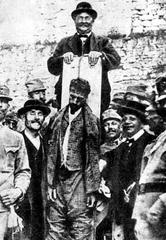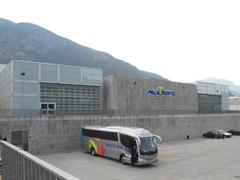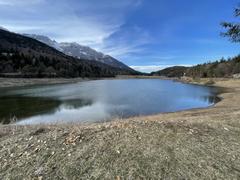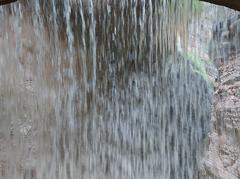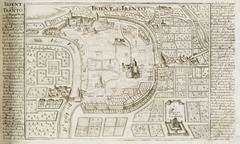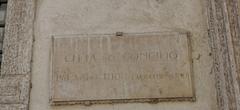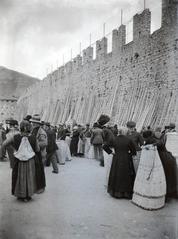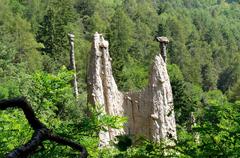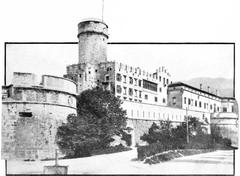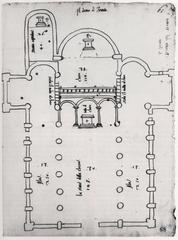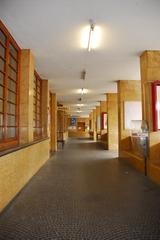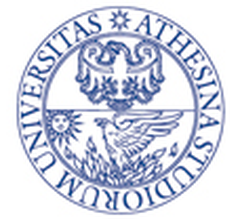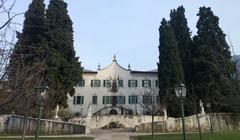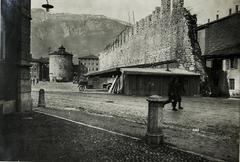Stadio Briamasco Visiting Hours, Tickets, and Guide: Exploring Trento’s Historic Stadium
Date: 04/07/2025
Introduction
Stadio Briamasco, centrally located in Trento, Italy, is much more than a football stadium—it is an emblem of the city’s sporting tradition, architectural evolution, and community pride. Since its inauguration in 1922, it has grown from a modest local ground into a modern, multifunctional venue and the home of A.C. Trento 1921. This comprehensive guide covers the stadium’s history, recent upgrades, visiting hours, ticketing options, accessibility features, travel tips, and nearby attractions, providing all the information you need to make the most of your visit to this iconic Trento landmark (Wikipedia; AC Trento).
Table of Contents
- Historical Overview
- Practical Information for Visitors
- Recent Transformations and Upgrades (2020–2025)
- Future Prospects and Urban Planning
- Unique Anecdotes and Challenges
- Frequently Asked Questions (FAQ)
- Conclusion
- References and Further Reading
Historical Overview
Early Origins and Foundation (1922–1945)
Stadio Briamasco opened in September 1922 as Trento’s principal sports venue, reflecting a growing national enthusiasm for football and athletics (Wikipedia; AC Trento). Initially, it featured a natural grass pitch and a six-lane athletics track, hosting football, archery, and cycling events. A.C. Trento 1921, founded a year prior, quickly made the stadium its home, turning it into a focal point for local sports culture (Wikipedia).
Post-War Development and Community Role (1945–1980s)
After World War II, Stadio Briamasco continued as a central hub for Trento’s sporting life. The stadium’s role expanded, hosting a variety of community events and regional competitions. Incremental improvements were made, but its essential structure—two main grandstands and a multi-use field—remained. The venue became deeply intertwined with the city’s identity, serving both as a sports arena and a gathering place for civic celebrations (OStadium).
Modernization and Renovations (1990s–2010s)
Structural Upgrades
By the 1990s, modernization was essential. The athletics track was removed, shifting the stadium’s focus solely to football and enhancing spectator experience (SportPeople). The stadium also temporarily hosted other clubs, such as Mezzocorona, and staged notable fixtures, including matches for the Italy U-21 national team (Wikipedia). These milestones elevated the stadium’s profile nationally.
Hosting High-Profile Events
Stadio Briamasco gained recognition for hosting Italy’s U-21 team and preseason friendlies for Serie A clubs. These events showcased the stadium’s capacity and further cemented its status in Italian football (Wikipedia).
Practical Information for Visitors
Visiting Hours
- Match Days: Gates open 60–90 minutes before kickoff.
- Non-Match Days: The stadium is generally closed to the public; however, special group visits or events may be arranged by contacting A.C. Trento 1921 (ilcalcio.net).
- Special Events: Check the official club or ASIS websites for up-to-date schedules.
Tickets and Entry
- Where to Buy: Tickets are available online via the official club website, at the stadium box office on match days, or through authorized resellers (BetsAPI).
- Prices: Generally range from €10–€25, with discounts for children, students, seniors, and families.
- Entry: Bring a valid photo ID. Gates open 60–90 minutes before matches. Security checks are standard, and prohibited items (e.g., glass, flares) are not allowed.
Accessibility
Stadio Briamasco is wheelchair accessible, with reserved seating, ramps, and accessible restrooms. Visitors with mobility challenges are advised to contact the club in advance to ensure availability and assistance.
Getting There and Parking
- Address: Via Roberto da Sanseverino, 43, 38122 Trento TN, Italy (Mapcarta).
- By Foot: 15-minute walk from Trento’s main train station.
- By Public Transport: City buses stop nearby; check Trentino Trasporti for routes.
- By Car: Limited parking is available near the stadium; public parking lots in the city center are recommended on match days.
- By Bicycle: Bike paths lead to the stadium, with racks on site.
Nearby Attractions
- Trento Cathedral (Piazza Duomo): Romanesque-Gothic architecture, 15 minutes’ walk.
- Buonconsiglio Castle: Medieval fortress and museum.
- Le Albere District & MUSE Museum: Modern urban design and science exhibits.
- Piazza Ezio Mosna: Lively square for pre- or post-match refreshments (Mapcarta).
Special Events and Guided Tours
Stadio Briamasco hosts youth tournaments, community events, and, occasionally, guided tours. Tours are not regularly scheduled but may be arranged for groups or during city festivals by contacting the club or ASIS directly.
Photographic Spots
- Tribuna Nord: Offers panoramic pitch views and Alpine backdrops.
- Curva Gunther Mair: Best for capturing the lively fan atmosphere.
- Stadium Exterior: Classic Italian architecture, especially near the main entrance.
Recent Transformations and Upgrades (2020–2025)
Major Renovations
Driven by A.C. Trento’s promotion to Serie C, the city funded extensive upgrades:
- New synthetic turf and pitch enlargement to 68 meters (La Voce del Nordest).
- Replacement of all seating, new stands, and a dedicated home supporter terrace (Curva Gunther Mair).
- Installation of modern lighting, TV tower, and removal of protective barriers for improved sightlines.
- Capacity set at approximately 3,250, spread across the Tribuna Nord “Giorgio Grigolli,” Tribuna Sud “Ito Del Favero,” and Curva Gunther Mair (AC Trento; Wikipedia).
Community and Cultural Impact
Upgrades have revitalized matchday experiences, drawing larger crowds and enhancing accessibility. Supporter groups like “Trento 1921” and “Nuova Guardia” have reinvigorated the stadium’s atmosphere (SportPeople).
Future Prospects and Urban Planning
While Stadio Briamasco remains Trento’s main stadium, there are ongoing discussions about constructing a new venue outside the city center. In late 2024, €45 million was allocated for feasibility studies on a potential new stadium in the Mattarello area (Corriere del Trentino). As of July 2025, Stadio Briamasco remains active and central.
Unique Anecdotes and Challenges
- Rabbit Infestation (2014): Rabbits burrowed onto the pitch, requiring humane removal measures (Wikipedia).
- COVID-19 Pandemic: Matches were played behind closed doors until May 2021, when fans gradually returned (Wikipedia).
Frequently Asked Questions (FAQ)
Q: What are Stadio Briamasco’s visiting hours?
A: Open mainly on match days; gates open 60–90 minutes before kickoff. For non-match visits, contact A.C. Trento or ASIS in advance.
Q: How do I buy tickets?
A: Online via the A.C. Trento 1921 website, at the stadium box office, or through authorized outlets.
Q: Is the stadium accessible for people with disabilities?
A: Yes; there are designated seating areas, ramps, and accessible restrooms.
Q: Are guided tours available?
A: Occasionally, by prior arrangement or during special events.
Q: What else is nearby?
A: Trento Cathedral, Buonconsiglio Castle, Le Albere district, and Piazza Ezio Mosna are all within walking distance.
Conclusion
Stadio Briamasco is a testament to Trento’s enduring love for sports and community gathering. Blending a century of tradition with modern upgrades, it offers a welcoming environment for football fans, history buffs, and travelers. Its central location provides easy access to Trento’s cultural and historical treasures, making it a must-visit for anyone exploring the city. For up-to-date information on tickets, visiting hours, and events, consult official sources or download the Audiala app for real-time updates and travel recommendations.
References and Further Reading
- Wikipedia: Stadio Briamasco
- A.C. Trento 1921 Official Website
- La Voce del Nordest: Nuovo Briamasco
- Corriere del Trentino: Nuovo Stadio a Trento
- ilcalcio.net: Stadio Briamasco Visiting Information
- OStadium: Stadio Briamasco Calendar
- SportPeople: Trento-Padova Atmosphere
- BetsAPI: Trento Team Info
- Mapcarta: Stadio Briamasco Location
- ASIS: Stadium Management
- Trento Tourism Board

